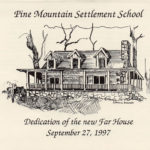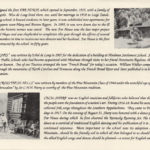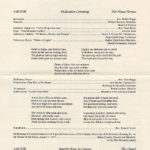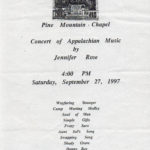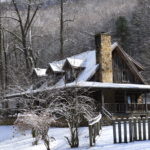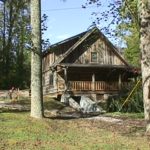Pine Mountain Settlement School
Series 10: BUILT ENVIRONMENT
FAR HOUSE II, 1997-present
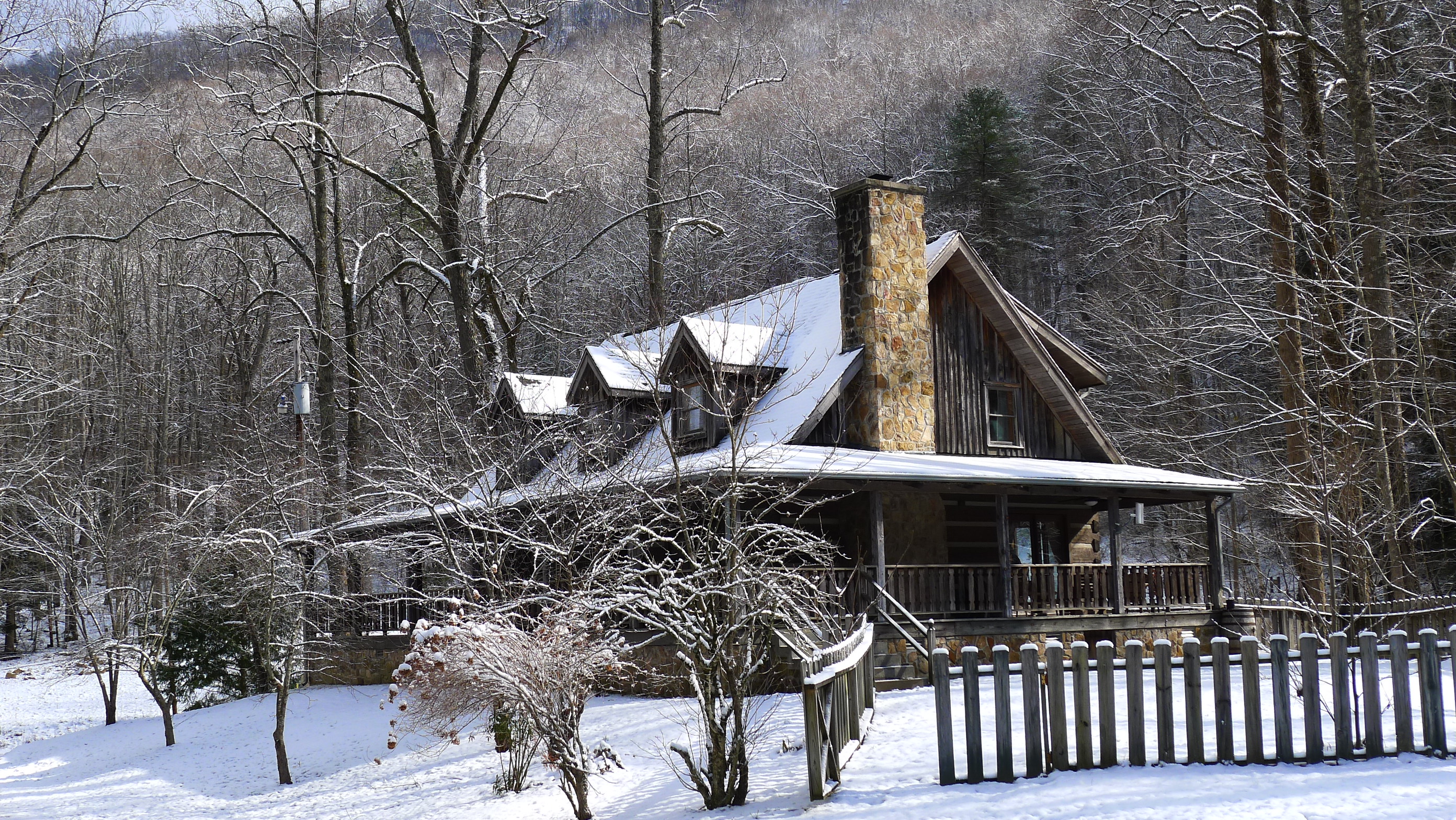
Far House II in snow, 2018. Photo: H. Wykle. [P1140455.jpg]
FAR HOUSE II, 1997-present
TAGS: Far House II, Far House I, dedication, dormitories, Ethel de Long, Mary Rockwell Hook, Mary and Burton Rogers, Paul Hayes, PMSS Board of Trustees, students, Kentucky Running Set, Cecil Sharp, guest housing, staff residences, Robin Lambert, Nancy Adams, Penny Lane, Miriam Pride, Geoff Marietta, Dr. James S. Greene III
The dedication of the Pine Mountain Settlement School dwelling called Far House II took place on September 27, 1997. September was the magic month for both Far House I and Far House II. Far House I, the first building which stood at the same location was dedicated in September of 1915. The new Far House II, its replacement, became the first new structure built on the campus in some fifty years.
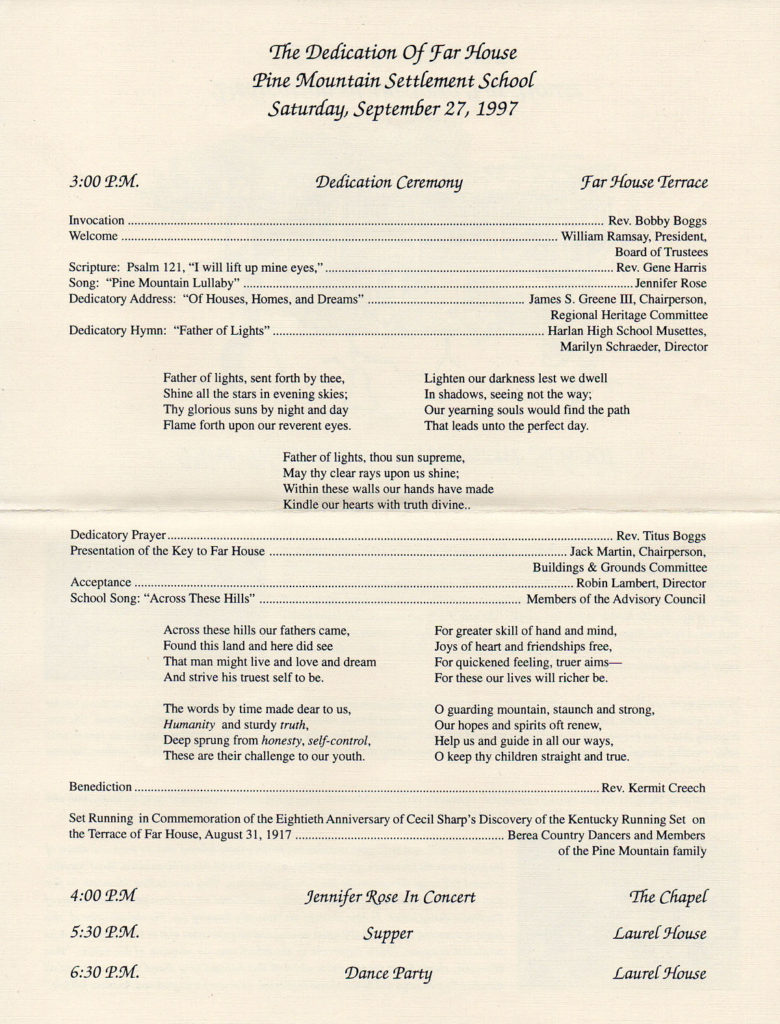
Far House II: Program for dedication ceremony, September 27, 1997. [far_house_II_003.jpg]
FAR HOUSE I: History
Far House I had been planned in 1914 as a dormitory dwelling for nineteen young boys and girls. It was initially supervised by Ethel de Long who served as teacher-housemother. She had also served as a consultant to the architect Mary Rockwell Hook. Miss de Long lived in the new building with the children until 1918 when she married Luigi Zande and moved into the new house – Zande House – he had built for her on the hillside just behind the children’s dormitory. Following her initial occupation, there was a succession of staff and students who lived in the building.
The older Far House I was heavily used, serving largely as student housing until its later years when the interior was subdivided into staff apartments. The last occupants of the building were Burton Rogers and his wife, Mary Rogers, who moved into the aging structure while Big Log was undergoing a major reconstruction. When Mary died, the badly degraded Far House I was beyond repair and the cost of reconstruction was perceived to be more than the cost of a new structure. Director Paul Hayes and the Board agreed the time had come to remove the building and to plan for a new Far House II.
FAR HOUSE II: Newest PMSS Building
The decision to remove the building and to replace it was both sad and exciting. The new building was a major project and became the last comprehensive undertaking of then-Director Paul Hayes. In many ways, the building became a fitting tribute to Hayes’ tenure as Director and as a former student of the School. He and so many other students had lived in the previous building or had used the terrace of the old building as a dance site for Morris and English Country Dancing. Hayes and many others remembered Far House I as the site of the famous performance of the Kentucky Running Set for the noted English folklorist, Cecil Sharp. For Paul Hayes, and others, acknowledging the earlier history, included retaining the original terrace when plans for the new building were being devised. Far House II was the last major project of Director Paul Hayes, before his untimely death in 1995 of cancer. It remains one of the newest and oldest building on campus.
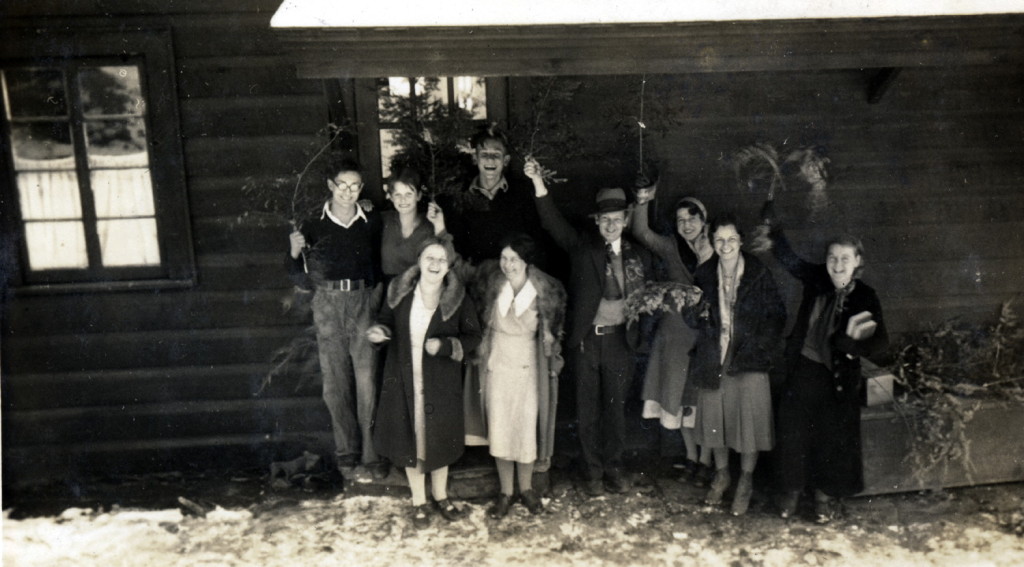
Group picture, waving branches, 1930s. Standing in front of the original Far House I terrace door. [X_100_workers_2572_mod.jpg]
While Far House II was constructed following the acknowledgment that the first Far House I could not be restored as it was structurally unsound, new Far House II faces many of the same ravages of location that brought the first house to ruin. Although Far House I had a basement to accommodate the coal-fired boiler that warmed the building, it had many points where it touched the moist soil of the North slope of the mountain. It is also in a direct path of the many storms that move up the steep wall of the valley from the west. Because it was designed and designated as a dormitory for students, the older Far House I also saw considerable wear and tear over the years and Far House II is now heavily used by visitors.
A slow and expensive course of disintegration is all too common in wooden buildings in damp climates, particularly those on the North face of Pine Mountain. In order to offset some of the issues of the older structure, the new building looked to an older structure — that of the log cabin. Cabins generally age well and age more slowly than wood-framed structures in damp climates. In log cabins, the slower aging process was assumed, though many who have lived at the School know that wood in the narrow and moist valley of Pine Mountain will always have its battles with moisture and yearn to return to the soil.
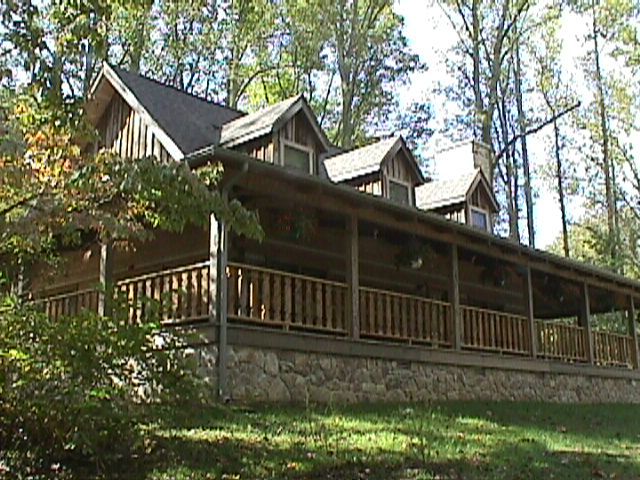
Far House II, front view. Photo: H. Wykle. [far_house_II_front-1.jpg]
Far House II was designed with specific intent but it was not as a dormitory replacement. It was intended to be the residence of the School’s Executive Director. The site, between West Wind and the Chapel, and just below Zande House, suggested a good North-side location for a Director’s home. From the west-facing porch, the building had a long Pine Mountain valley view and the warmth of the afternoon sun on cold winter days promised an inviting residence.
Since its construction, the building has veered away from its original intent to house students. It was built to house the administrative staff of the School. After housing four Directors including Robin Lambert, the first to occupy the house while also commuting over the mountain to her home in Harlan, she was followed by Nancy Adams, then Penny Lane and briefly, Miriam “Mim” Pride who served as an Interim Director for approximately fifteen months until 2016. Most all of these Directors noted the location put their private lives in a fish-bowl and adjacent to the active and sometimes very noisy central dormitory, West Wind. When nearby Zande House became a guest house, the visitor load on the North side of the campus again increased. Thus, in 2016, when the new Director Geoff Marietta and his family moved to Pine Mountain, they chose the more secluded location of Big Log at the East end of the campus — returning Big Log to a Director residence.
During Director Marietta’s years, the new building returned to its dormitory origins and became a guest dwelling. It quickly became a favorite of visitors staying at Pine Mountain. As the newest building on the campus, the full kitchen and two modern baths and the adjacency to the Chapel made it convenient for wedding parties and family reunions and small workshop groups. The five bedrooms and two baths easily accommodates large groups but still provides the intimacy often preferred by families and close friends.
Images of the Dedication: “OF HOUSES, HOMES, AND DREAMS”
On September 27, 1997, Dr. James Greene III, a member of the Pine Mountain Settlement School Board of Trustees, participated in the dedication of the new Far House II. He carefully documented the dedication and loaded the archival material onto three CDs that detail the dedication and events surrounding the history of both Far House I and Far House II. In this material he has provided his dedicatory address, “Of Houses, Homes, and Dreams” for the PMSS Archive. It is a carefully crafted introduction to both the past and to the future of the School while describing the place of the new building in the long cycle of construction at the School. It is a tribute to those who participated in the creation of the newest building at Pine Mountain Settlement while honoring the ideals and values of those who shaped the role of buildings on the large campus.
Jamie has provided an outline of resources at the end of this page and images taken during the dedication of the new building for those wishing to know more about the birth of this youngest of the buildings at the School … the “new old house.”
OF HOUSES, HOMES, AND DREAMS
Today we celebrate completion of a house. Milly [Mildred Mahoney, Interim Director and staff member] calls it our “new old house” for it has the look and air of mountain dwellings of an earlier time, and it bears a name distinguished in Pine Mountain history. Many of us gathered here today have fond memories of its predecessor. Some of us were students who experienced the joys and anxieties of childhood within its walls. Others were staff members who here found a retreat from the demands of a very public institution. Others of us remember Far House hospitality — I will always treasure having tea by the great stone fireplace. But this is a new house, and as Robin [Lambert] and Robert [Author, Robert Gipe] live in it, it will begin to take on its own memories and build its own reputation.
Yet, even as we celebrate this house, we are already dreaming of what we’ll build next — of renovations to Draper and of a community house that will offer new opportunities for service. For there’s something about a building which appeals to human beings. It’s exciting. First, you dream. What kind of building it will be? How will it look? Then you work out the details trying to include everything you dreamed of yet stay within your budget. Next comes the actual construction each step bringing the dream closer to reality (and sometimes the builder closer to bankruptcy), and finally the grand day arrives when it’s finished, and you can move in.
But the attraction is more than just excitement. We sense that building is a way of leaving our mark on the land, of defining our presence, of achieving a semblance of permanence in a rapidly changing world. In American culture, building is also equated with progress. Our colonial forebears were not content with the natural beauty around them — they had to tame and shape it. In pioneer Kentucky, you secured your claim to a piece of land by making “improvements” on it: building a cabin and planting a crop of corn. An old nineteenth-century print depicts the progress of a neighborhood from first settlement to mature old age. As the built environment prospers, the natural environment shrinks away.
Among institutions, building often becomes an end in itself. Several years ago a certain university tried hard to recruit new students by bragging of all the new buildings it had — modern dormitory towers with all the amenities, modern classrooms with all the technology. But its academic program lacked rigor, and its claim to fame among undergraduates lay in the quality of life among the Greeks and the bars. Which leads me to a key point: buildings are an expression of an institution’s value.
The first impression of newcomers to Pine Mountain is of the physical beauty of the place. But it is not this beauty that gives Pine Mountain its essence; rather the beauty is an expression of that essence. In the words of Mary Rockwell Hook [School Architect]:
“The founders of Pine Mountain knew that the physical characteristics of the land and the buildings expressed the spiritual ideals of the school. Therefore they wanted to keep the native character of the landscape setting, and took, through the course of years, unimaginable pains to preserve each detail that contributed to the picture of a characteristic mountain valley.”
Mary Rockwell Hook
The setting, she wrote, is “a setting that says quite plainly to the casual observer that one of the ideals of Pine Mountain is the preservation of the best elements in mountain culture and mountain character.”
The physical plant was and still is part of the curriculum of the school. In boarding school days, one of Pine Mountain’s goals was to teach young people how to make a comfortable life for themselves in the mountains and how to live a life of quality without large expenditures of money. Rather than house students in a couple of large dormitories, Pine Mountain had smaller houses — Old Log, Big Log, Farm House, Practice House, Laurel House, Far House — where groups of ten or twenty students lived as a family in company with two or three workers and a housemother. The daily routine of the houses was carefully planned to model and give students practice in the habits the school sought to develop. Yet at the same time, it was a genuine life full of warmth and love, because those were core values of the place: “Pine Mountain isn’t an institution,” wrote one of the founders. “It is a life; people aren’t here just to earn their livings; they ARE living.” Today the campus is our textbook; the way we care for our land models the environmental commitment we seek to teach. Teaching begins the moment our students, young and old, arrive on campus. The vista that greets them as they look toward Laurel House and the Chapel shows that natural and built environments can coexist in harmony. Trips into the creek for crayfish and salamanders or hikes up the mountain to look at wildflowers or rock formations. awaken their consciousness of the natural world. The setting creates an ambiance that supports the formal instruction the staff will give them.
The physical plant is thus a tool to greater ends. Just as a house shelters those who dwell within, so an institution shelters values and makes welcome those who love them. The young Ethel de Long knew this when she wrote the dedication hymn which we revive today. This hymn is not a song of thanksgiving for the building (though the building it celebrated was secured at great price) not is it a prayer of blessing or consecration. Rather it is a call for those who will occupy the building to walk in the light, to follow the path “that leads to the perfect day.” The building is but a vehicle in the search for divine truth, a place where we can grow in wisdom and understanding through working together. The Psalmist knew this too. “Except the Lord build a house, they labor but in vain that build it.” Fundamental values come first and undergird the enterprise.
Pine Mountain must be a shelter for those values which sustain us who live on the edge of a new millennium. “The earth is a house for us all, “writes the children’s author, Mary Ann Hoberman. Pine Mountain has committed itself to make that house a better place in which to live by educating the inhabitants. Today’s news makes this work compelling. Water quality is a major problem in our county. Irresponsible logging and mining operations, inadequate planning for land use, threats to already endangered species, haphazard and thoughtless disposal of trash … these are issues that touch us where we live. On the social front, our community wrestles with issues of education, recreational opportunities, and access to health care.
If we are to tackle these problems and others, we must have both knowledge and spirit. Seventy-six years ago, one of Robin’s [Robin Lambert] predecessors wrote:
“We do want Pine Mountain to give our children tools that will make them fit for the modern life that is coming in, but also we want it to be a place where hearts and souls are trained. Spirit is the most important thing in the whole world.”
Source ? William Creech ?
As we dream our dreams of where Robin’s leadership will take us and of what our new community house will be, let us keep this vision foremost in our minds.
In closing, I would give a charge:
Robin and Robert, live in this house and make it a home where love and friendship dwell. And I call upon all of us — friends, staff, Trustees — to join in the adventure that is this great settlement institution, each finding that role that needs his or her unique gifts and filling it, in the spirit of Pine Mountain, to further the kingdom of God in our tired and trouble world.
James S. Greene III
Dedicatory Address
Far House Dedication
Pine Mountain Settlement School
September 27, 1997
GUIDE TO DEDICATION ACTIVITIES FOR FAR HOUSE II CD SETS
(3 CDs on file in Archive. See: FAR HOUSE II)
Disc 1
1. Guide to Collection
2. Dedication Program
3. Dedicatory Address “Of Houses, Homes, and Dreams.” James S. Greene III
4. Dedicatory Hymn “Father of Lights” Text – Ethel de Long, Tune – William Walker. This arrangement was sung by the Harlan High School Musettes ©1997 by James S. Greene III
5. Program for Concert of Appalachian Music given by Jennifer Rose the afternoon of the dedication
PHOTOS: Far House II Oct 1996
Disc 2
Photos: Far House Dedication 001-006
Disc 3
Photos: Far House Dedication 007-011
The photos on these discs were taken by James S. Greene III. (Includes: ID Number, Occasion, Identifications, Date) [Permission for use granted by James Greene III, 10/2019]
GALLERY I: Pre-Dedication Photos
-
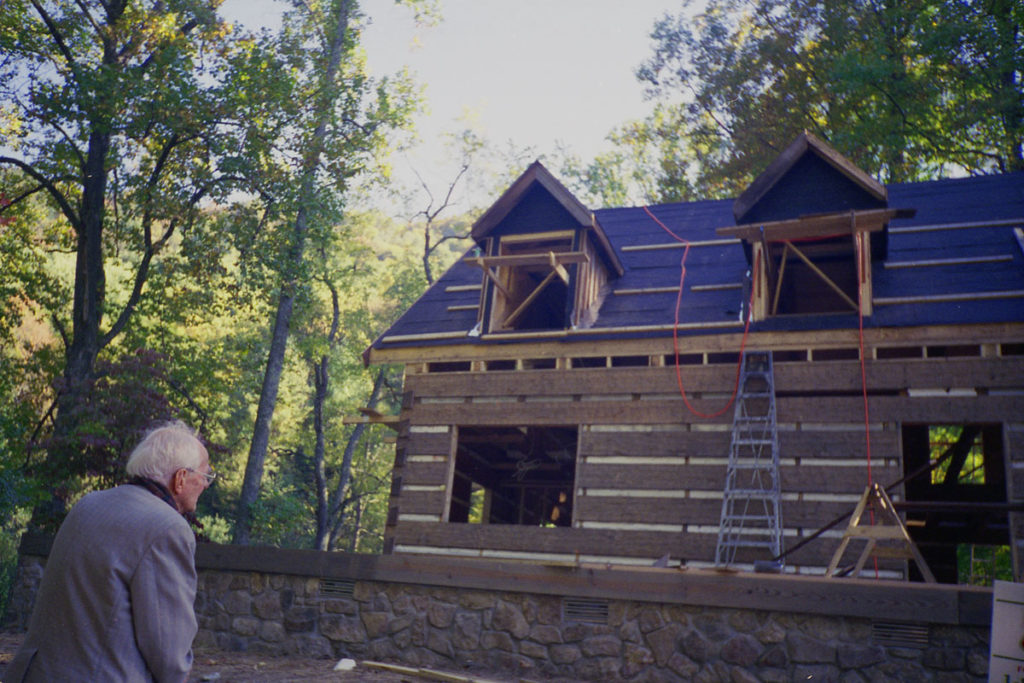
01 -
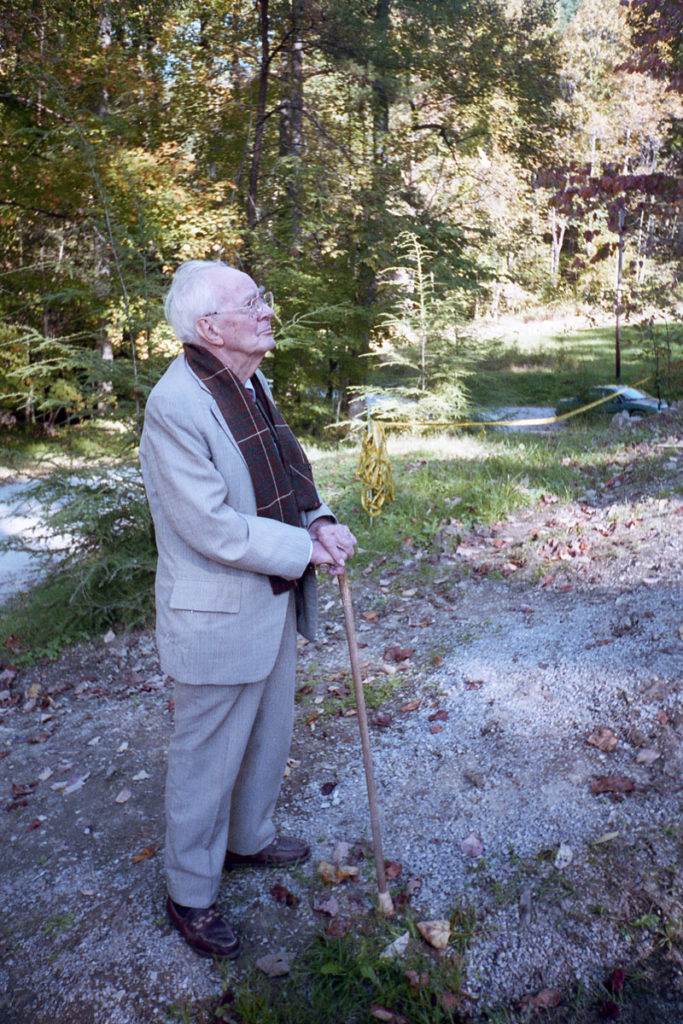
02 -
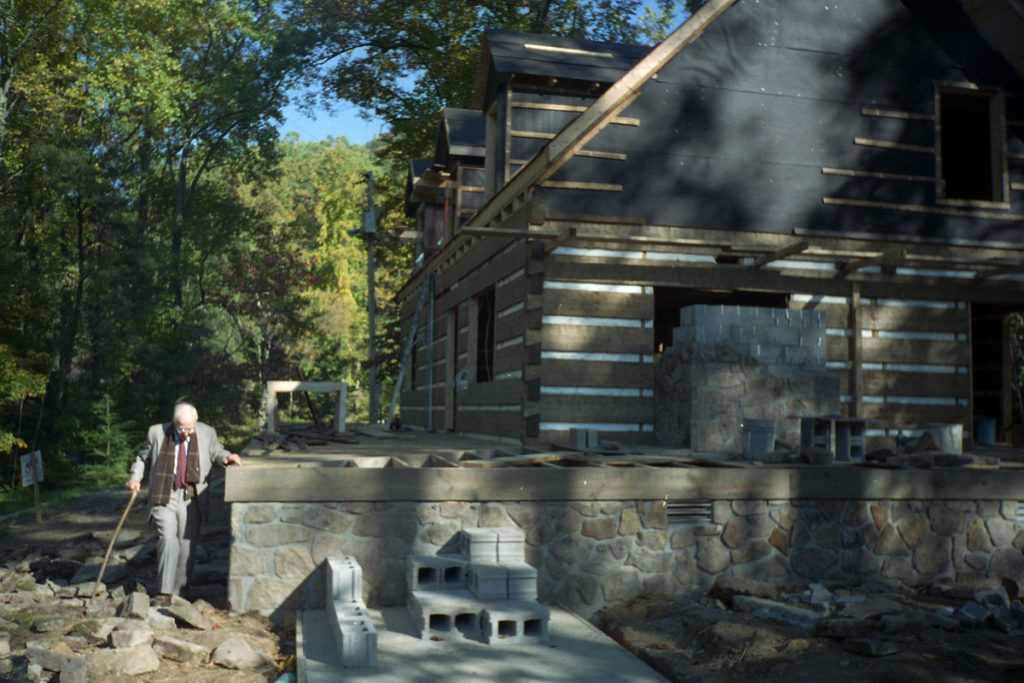
03 -
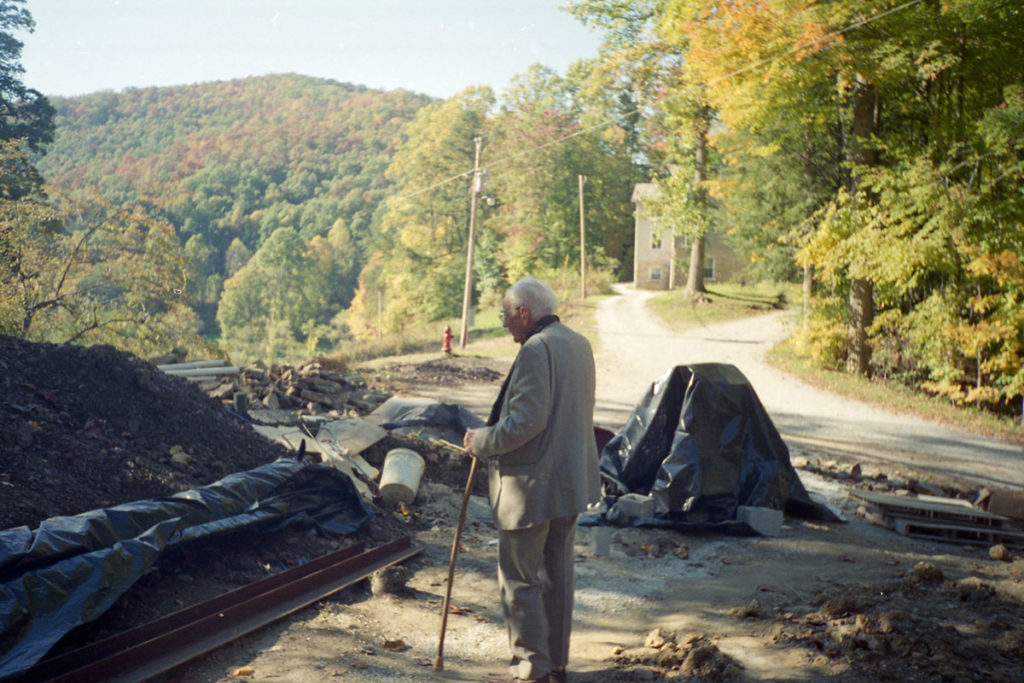
04 -
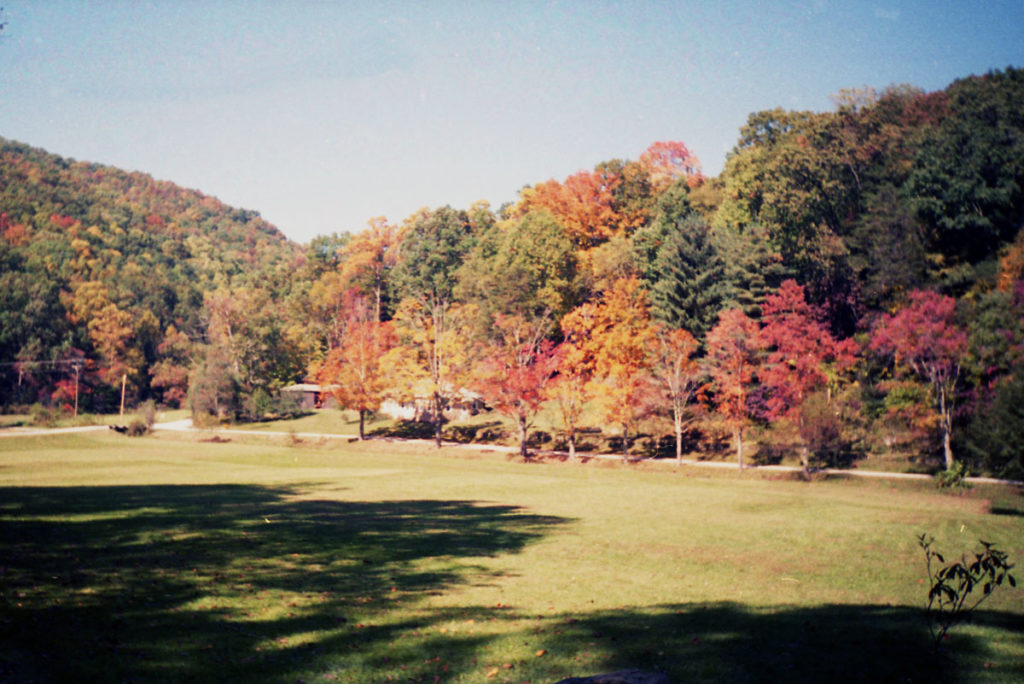
05
- Far House II Oct 1996_001 Time of Fall 1996 Board meeting Burton Rogers by Far House II under construction October 12, 1996
- Far House II Oct 1996_002 Time of Fall 1996 Board meeting Burton Rogers in drive by Far House October 12, 1996
- Far House II Oct 1996_003 Time of Fall 1996 Board meeting Burton Rogers by Far House II under construction October 12, 1996
- Far House II Oct 1996_004 Time of Fall 1996 Board meeting Burton Rogers at Far House site West Wind in background October 12, 1996
- Far House II Oct 1996_005
Time of Fall 1996 Board meeting
View of Campus looking towards Office
October 12, 1996
GALLERY II: Dedication Photos
-
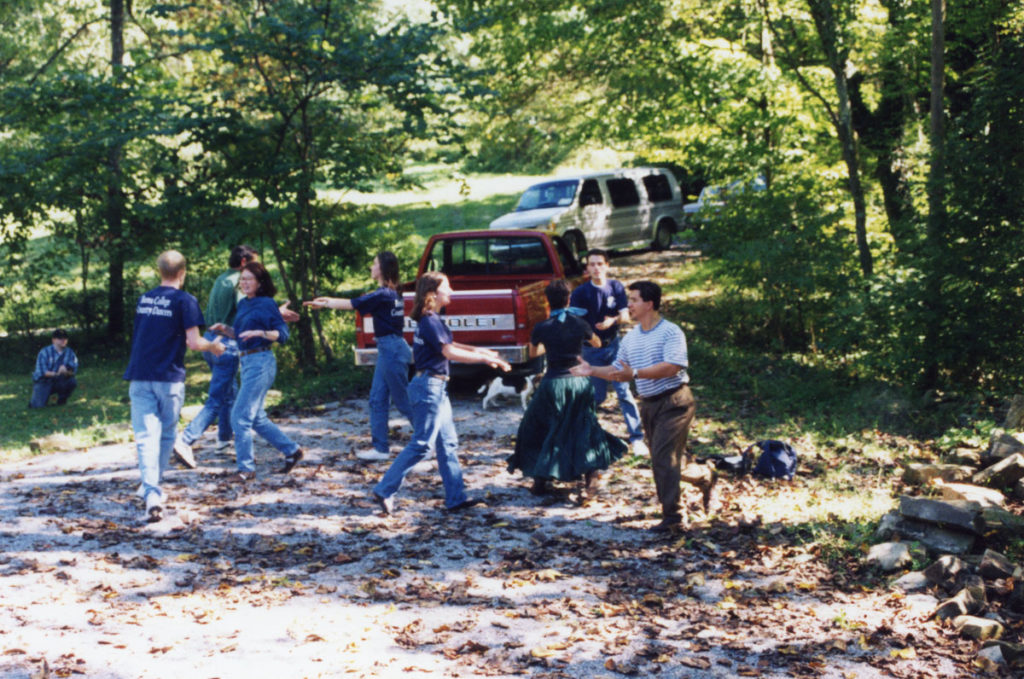
01 -
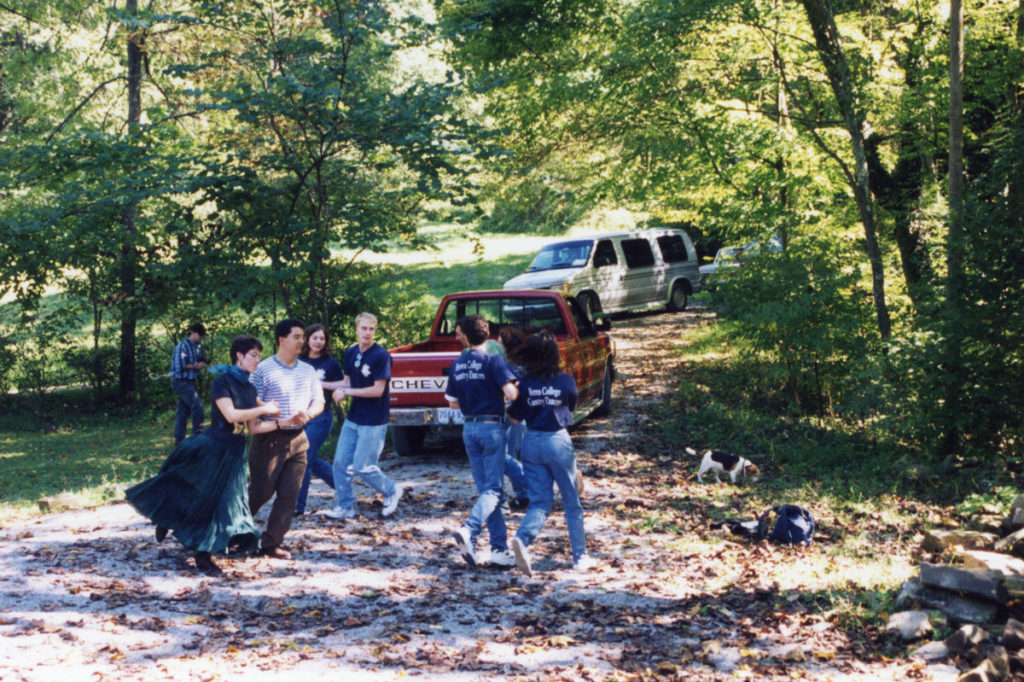
02 -
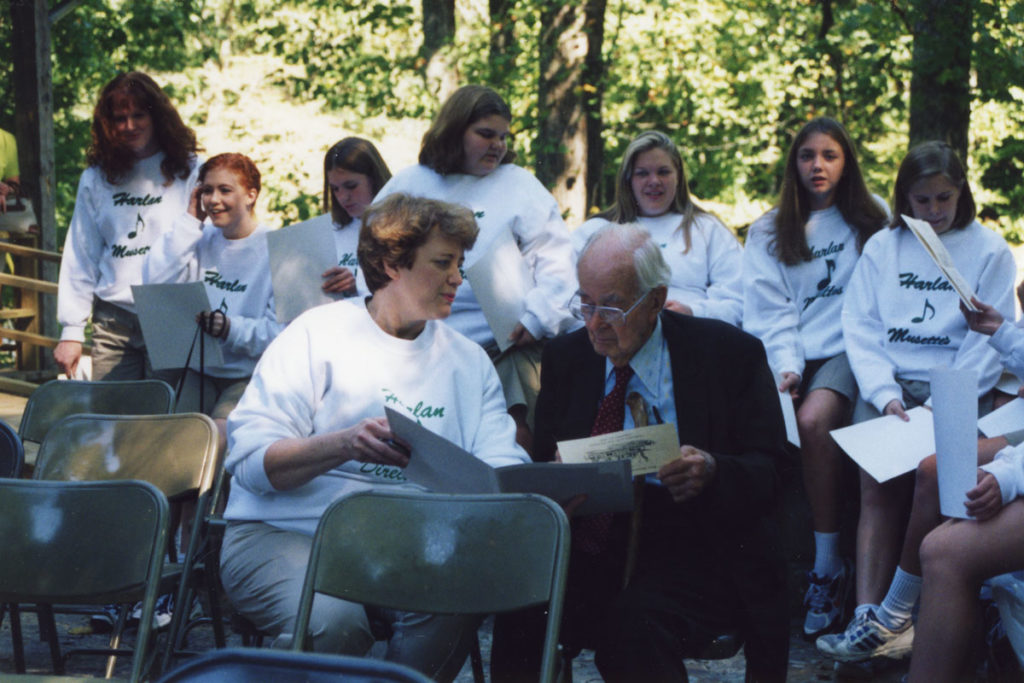
03 -
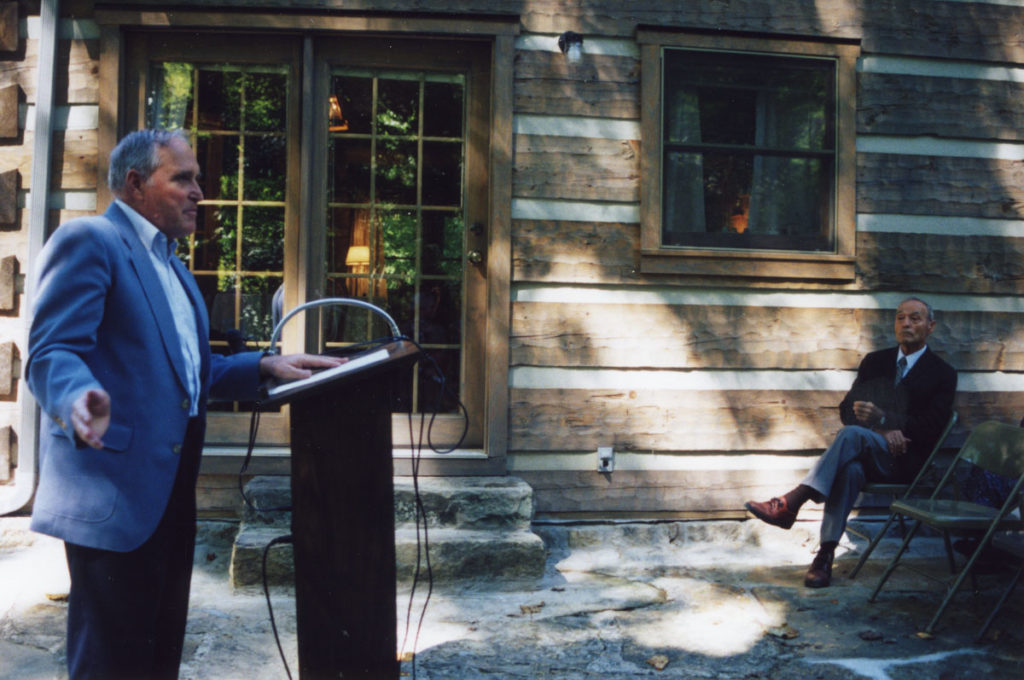
04 -
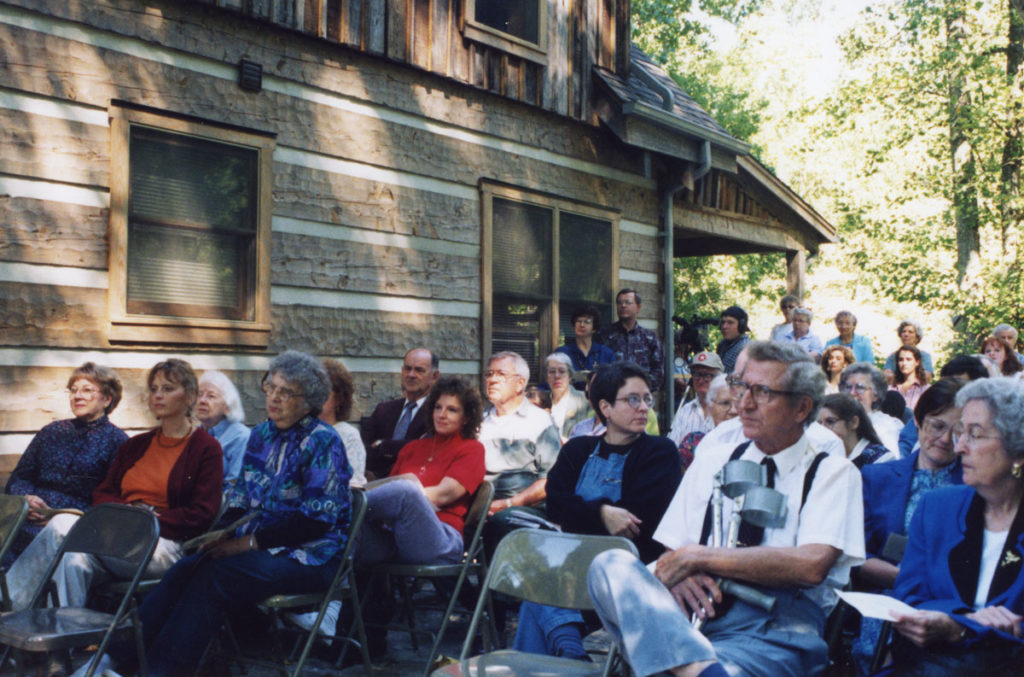
05 -
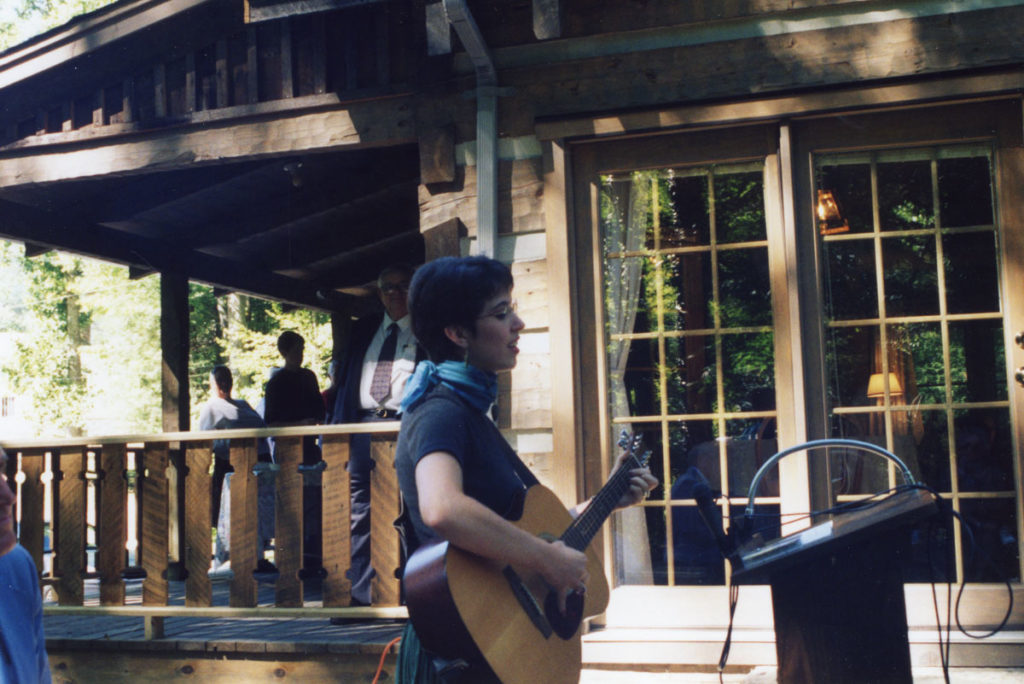
06 -
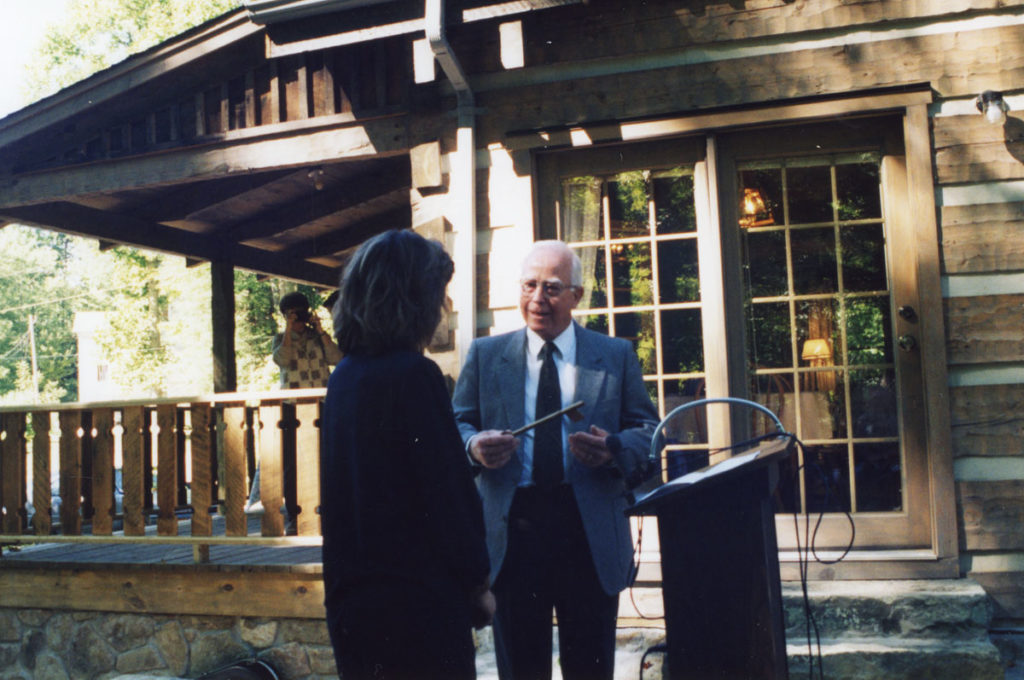
07 -
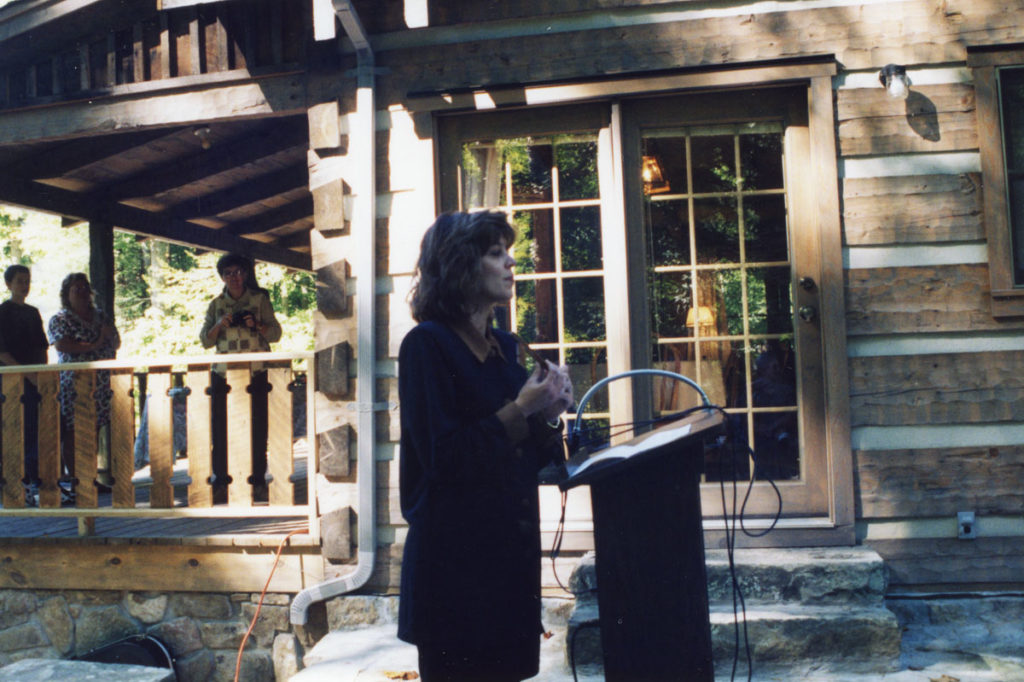
08 -
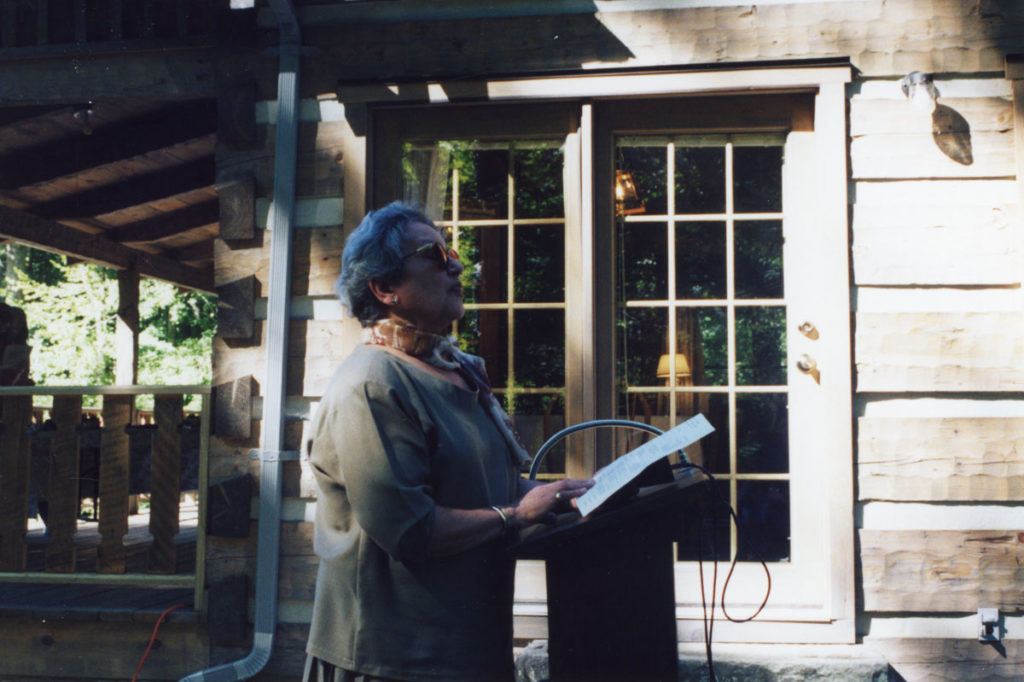
09 -
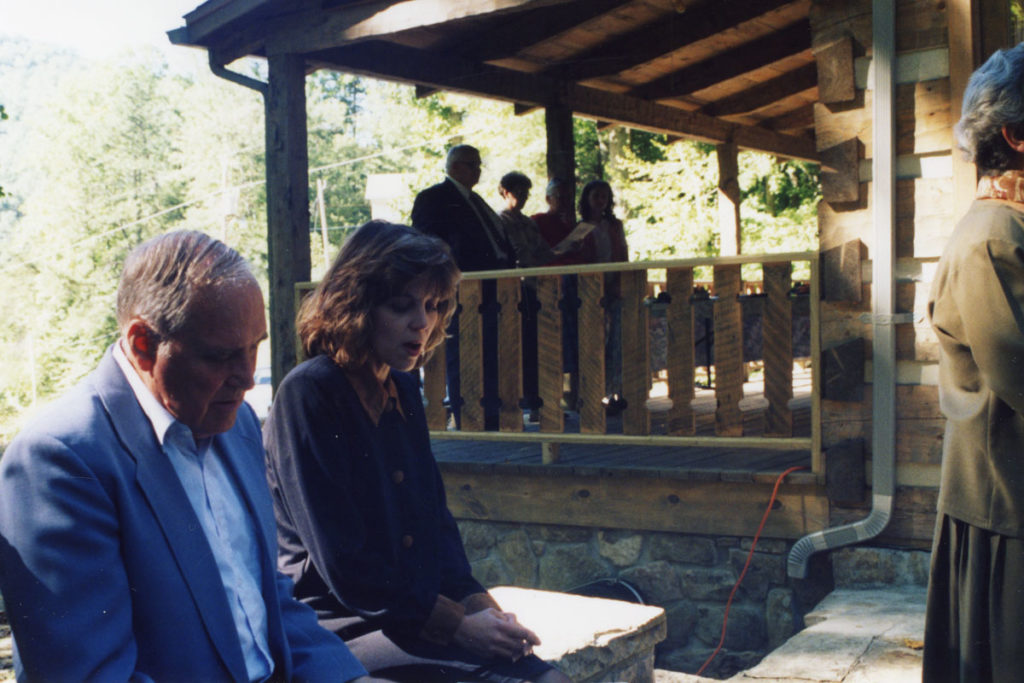
10 -
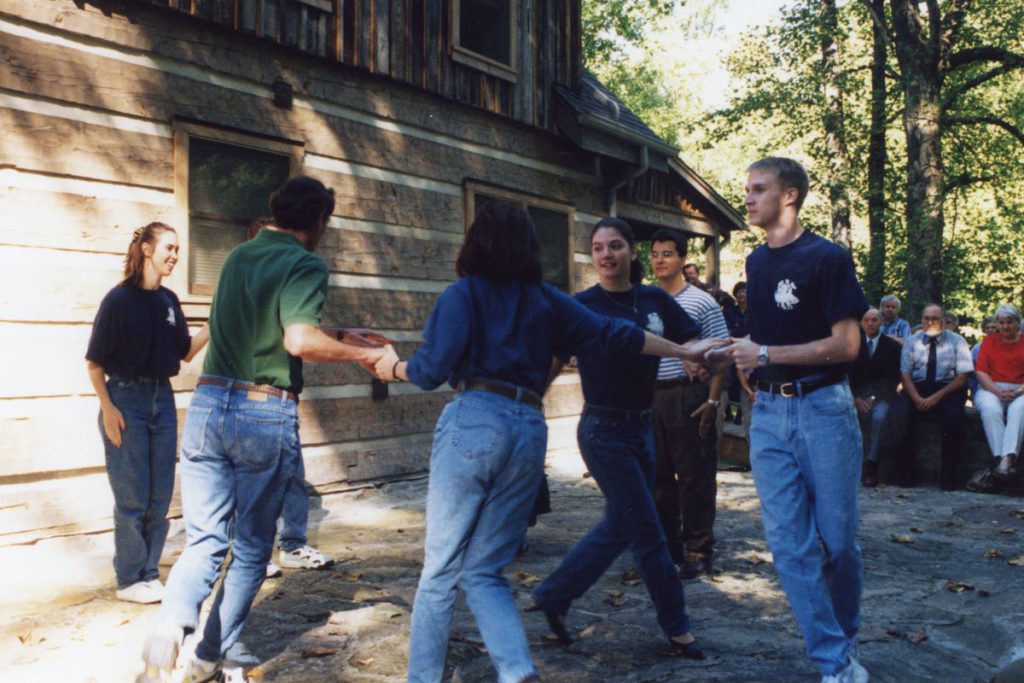
11
- Far House Dedication_001
Dedication of Far House II
Berea Country Dancers rehearsing
September 27, 1997 - Far House Dedication_002
Dedication of Far House II
Berea Country Dancers rehearsing
September 27, 1997 - Far House Dedication_003
Dedication of Far House II
Marilyn Schraeder, Burton Rogers, Ensemble of Harlan High School Musettes
September 27, 1997 - Far House Dedication_004
Dedication of Far House II
Bill Ramsay, Board President, giving the welcome. Trustee Bill Hayes on right
September 27, 1997 - Far House Dedication_005
Dedication of Far House II
Audience. Front row: Trustees Lois Hoskins and Clara Pope; [ ] [ ] Trustee Martha Pride. Trustee Milly Mahoney standing at back in light blue. September 27, 1997 - Far House Dedication_006
Dedication of Far House II
Jennifer Rose singing an original song, “Pine Mountain Lullaby”! (Trustee Bill Leach is on porch behind her) September 27, 1997 - Far House Dedication_007
Dedication of Far House II
Trustee Jack Martin presents the key to Executive Director Robin Lambert
September 27, 1997 - Far House Dedication_008
Dedication of Far House II
Executive Director Robin Lambert makes acceptance speech September 27, 1997 - Far House Dedication_009
Dedication of Far House II
Trustee Jane Bishop Hobgood leads the singing of “Across These Hills” September 27, 1997 - Far House Dedication_010
Dedication of Far House II
Bill Ramsay and Robin Lambert during singing of “Across These Hills.” Trustee Bill Leach is on porch behind them. September 27, 1997 - Far House Dedication_011
Dedication of Far House II
Set Running Commemorating 80th Anniversary of Cecil Sharp’s discovery of the Kentucky Running Set on this terrace. Berea Country Dancer and members Pine Mtn family
September 27, 1997
GALLERY: Far House II
- Far House II drawing on cover of Dedication Ceremony Program, 1997. [far_house_II_001]
- Far House II Old and New. Page 2 of Dedication Ceremony Program, 1997. [far_house_II_002]
- Far House II The Dedication Ceremony Program, 1997, page 3. [far_house_II_003.jpg]
- Far House II. Chapel Program for dedication of Far House II. [far_house_II_004]
- Far House II in snow. Photo by Helen Wykle. [P1140455.jpg]
- Far House II, back view. Photo by Helen Wykle. [far_house_II_back]
See Also:
NOTES – 1997 Spring
Return To:
BIOGRAPHY – A-Z
| Title | FAR HOUSE II |
| Alt. Title | New Far House |
| Identifier | https://pinemountainsettlement.net/?page_id=71516 |
| Creator | Pine Mountain Settlement School, Pine Mountain, KY |
| Alt. Creator | Helen Hayes Wykle ; Ann Angel Eberhardt |
| Subject Keyword | Far House II ; Far House I ; dedication ; dormitories ; Ethel de Long ; Mary Rockwell Hook ; Mary and Burton Rogers ; Paul Hayes ; PMSS Board of Trustees ; students ; Kentucky Running Set ; Cecil Sharp ; guest housing ; log cabins ; staff residences ; Robin Lambert ; Nancy Adams ; Penny Lane ; Miriam Pride ; West Wind ; Geoff Marietta ; Big Long ; Dr. James Green III ; dedicatory address ; Mildred Mahoney ; physical plant ; housemothers ; dedication hymn; |
| Subject LCSH | Pine Mountain Settlement School (Pine Mountain, Ky.) — History. Harlan County (Ky.) — History. Education — Kentucky — Harlan County. Rural schools — Kentucky — History. Schools — Appalachian Region, Southern. |
| Date | 2019-10-31 hw |
| Publisher | Pine Mountain Settlement School, Pine Mountain, KY |
| Contributor | n/a |
| Type | Collections ; text ; image ; |
| Format | Original and copies of documents and correspondence in file folders in filing cabinet. |
| Source | Series 10: Built Environment |
| Language | English |
| Relation | Is related to: Pine Mountain Settlement School Collections, Series 10: Built Environment. |
| Coverage Temporal |
1915 – 1997 |
| Coverage Spatial |
Pine Mountain, KY ; Harlan County, KY ; |
| Rights | Any display, publication or public use must credit the Pine Mountain Settlement School. Copyright retained by the creators of certain items in the collection, or their descendants, as stipulated by United States copyright law. |
| Donor | n/a |
| Description | Core documents, correspondence, writings and administrative papers created by or addressed to [full name]; clippings, photographs, publications, illustrations by or about [full name]. |
| Acquisition | n/d |
| Citation | “[Identification of Item],” [Collection Name] [Series Number, if applicable]. Pine Mountain Settlement School Institutional Papers. Pine Mountain Settlement School, Pine Mountain, KY. |
| Processed By | Helen Hayes Wykle ; Ann Angel Eberhardt ; |
| Last Updated | 2019-11-04 hhw; |
| Bibliography | |
| Source | “Far House II,” Series 10: Built Environment. Pine Mountain Settlement School Institutional Papers. Pine Mountain Settlement School, Pine Mountain, KY. |

